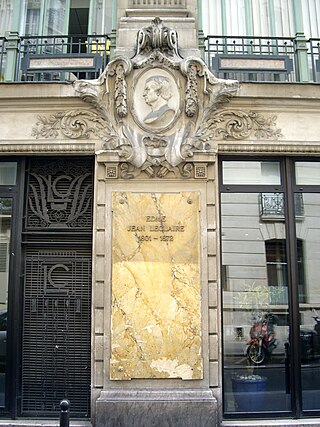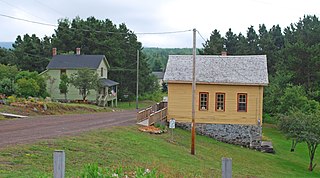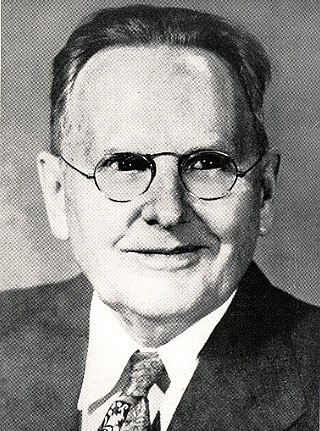
Edwardsville is a city located in, and is the county seat of, Madison County, Illinois, United States. As of the 2020 census, the population was 26,808. The city was named in honor of Ninian Edwards, then Governor of the Illinois Territory.

LeClaire is a city in Scott County, Iowa, United States. The population was 4,710 in 2020, a 65.4% increase from 2,847 in 2000, making it one of the fastest-growing communities in the Quad Cities. LeClaire is considered a suburb and part of the Quad Cities Metropolitan Area, which include the area of Davenport and Bettendorf, Iowa, and Rock Island, Moline, and East Moline, Illinois.

Bodie is a ghost town in the Bodie Hills east of the Sierra Nevada mountain range in Mono County, California, United States. It is about 75 miles (121 km) southeast of Lake Tahoe, and 12 mi (19 km) east-southeast of Bridgeport, at an elevation of 8,379 feet (2554 m). Bodie became a boom town in 1876 after the discovery of a profitable line of gold; by 1879 it had a population of 7,000–10,000.

Pullman, one of Chicago's 77 defined community areas, is a neighborhood located on the city's South Side. Twelve miles from the Chicago Loop, Pullman is situated adjacent to Lake Calumet.

Chatham is one of the 77 community areas of the city of Chicago, Illinois. It is located on the city's South Side. It includes the neighborhoods of Chatham-Avalon, Chatham Club, Chesterfield, East Chatham, West Chatham and the northern portion of West Chesterfield. Its residents are predominantly African American, and it is home to former Senator Roland Burris. Housing many city employees and other officials, Chatham has been a central area for Chicago's middle-class African Americans since the late 1950s.

Edme-Jean Leclaire was a French economist and businessman. He developed an early system of employee profit-sharing.
Le Claire, LeClair, LeClaire or Leclair is a French or Francophone surname which can refer to:

Pullman National Historical Park is a historic district now located in Chicago, which in the 19th century was the first model, planned industrial community in the United States. The district had its origins in the manufacturing plans and organization of the Pullman Company and became one of the most well-known company towns in the United States, as well as the scene of the violent 1894 Pullman strike. It was built for George Pullman as a place to produce the famous Pullman railroad-sleeping cars.

The Prairie Avenue District is a historic district in the Near South Side community area of Chicago, Illinois. It includes the 1800 and 1900 blocks of South Prairie Avenue and the 1800 block of South Indiana, and 211-217 East Cullerton. It was the site of the Battle of Fort Dearborn and became the city's most fashionable residential district after the Great Chicago Fire. It was designated a Chicago Landmark on December 27, 1979. The district was added to the National Register of Historic Places on November 15, 1972. The John J. Glessner House, designed and built by Henry Hobson Richardson in 1885–1886 at 1800 S. Prairie Avenue, has been restored as a historic house museum, and is open for public tours. In 2006, the Prairie District Neighborhood Alliance, a non-profit organization was formed to provide representation for thousands of South Loop residents, including the Prairie Avenue District, Central Station, Museum Park, Motor Row, and the South Michigan Avenue Corridor, as well as other areas of the Near South Side.

Wycombe is an unincorporated community that is primarily located in Wrightstown Township with a portion of it located in Buckingham Township, Bucks County, Pennsylvania, United States.

Loop Retail Historic District is a shopping district within the Chicago Loop community area in Cook County, Illinois, United States. It is bounded by Lake Street to the north, Ida B. Wells Drive to the south, State Street to the west and Wabash Avenue to the east. The district has the highest density of National Historic Landmark, National Register of Historic Places and Chicago Landmark designated buildings in Chicago. It hosts several historic buildings including former department store flagship locations Marshall Field and Company Building, and the Sullivan Center. It was added to the National Register of Historic Places on November 27, 1998. It includes 74 contributing buildings and structures, including 13 separately listed Registered Historic Places, and 22 non-contributing buildings. Other significant buildings in the district include the Joffrey Tower, Chicago Theatre, Palmer House, and Page Brothers Building. It also hosts DePaul University's College of Commerce, which includes the Kellstadt Graduate School of Business and the Robert Morris College.

The Garrison Landing Historic District, also known as Garrison's Landing, is a small commercial and residential area located between what is now the Metro-North Hudson Line and the Hudson River in Garrison, New York, United States. Its buildings were mostly erected in the 1850s, around the time the Hudson River Railroad, later the New York Central, laid the tracks. Much of the construction was spearheaded by the president of a local ferry company to provide rental housing for local workers. His descendants lived in the area until the late 20th century and led efforts to preserve it, founding and helping to run two organizations for that purpose.

The Central Mine Historic District is a historic district located off US 41 in Upper Michigan. The mine itself was designated a Michigan State Historic Site in 1958, while the surrounding district was designated a Michigan State Historic Site in 1973 and listed on the National Register of Historic Places in 1974.

Nils Olas Nelson was an American industrialist and businessman who was the founder of the N. O. Nelson Manufacturing Company.

The Antoine LeClaire House is a historic building located on the east side of Davenport, Iowa, United States. It is a community center that was built as a private home by one of the founders of the city of Davenport. It also housed two of Davenport's Catholic bishops. The home was constructed in 1855. It was listed on the National Register of Historic Places in 1974, and on the Davenport Register of Historic Properties in 1992.

Hewitt & Emerson was an architectural firm based in Peoria, Illinois. It was founded in 1909 as the partnership of architects Herbert E. Hewitt and Frank N. Emerson. After 1927 it was known successively as Hewitt, Emerson & Gregg; Emerson, Gregg & Briggs and Gregg & Briggs. It was active until at least the 1960s.

Bardwell station was a historic train station at the city of Bardwell in the far western part of the U.S. state of Kentucky. Constructed in the late nineteenth century along the railroad's main line, it was the center of life for local residents and served as a significant maintenance site for the railroad. As a simple functional structure, the depot qualified for designation as a historic site in 1976, but it no longer stands.

Sedley Taylor was a British academic, librarian and one of the Professors at the Trinity College in Cambridge, England. He is known for his works on the science of music and on profit-sharing in industry.

The Town House is a historic apartment building located at 718 S. 7th Street in Springfield, Illinois. The high-rise building is composed of an 11-story section and a 13-story section joined by a 14-story connector. Built in 1958, the International Style building was designed by Chicago architectural firm Shaw, Metz and Dolio. Springfield's Franklin Life Insurance Company underwrote the building; while it was originally intended to serve as employee housing, it quickly became a desirable residence for the general public as well. The building was the first high-rise luxury apartment complex in Springfield and was likely inspired by the earlier Hickox Apartments, a 1920s complex which set standards for luxury apartments in Springfield. It attempted to bring the more urban lifestyle of large Midwestern cities to comparatively smaller Springfield, and early residents boasted of their access to downtown and reduced housework. Shortly after its construction, however, the national trend of dispersed suburban homes made its way to Springfield; as a result, the Town House was the only luxury high-rise apartment ever built in the city.

George Awsumb was a prominent Norwegian-American architect in the first half of the 20th century. Awsumb defined architecture as “frozen music” designed for the “man on the street.” He was influenced by his early life, European travels, and prevailing architectural trends of his time. His eclectic, progressive portfolio included neoclassical, Gothic Revival, Prairie School, and International Style designs. Several buildings that Awsumb designed have been in continuous use in the American Midwest and South for over 100 years. In particular, Awsumb began a family architectural legacy that contributed to the progress and development of Memphis, Tennessee.




















